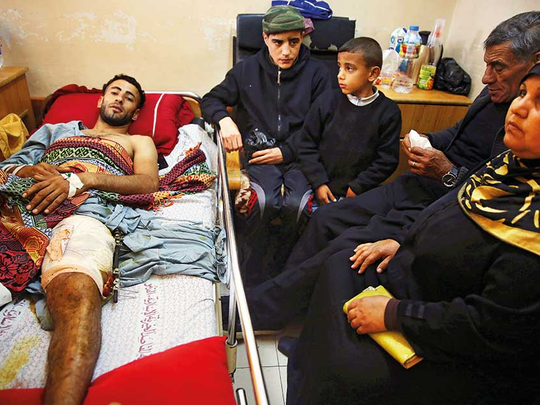
Gaza: Raed Jadallah belonged to an exclusive club — a small band of surfers who escaped the claustrophobia of blockaded Gaza by riding the waves of the Mediterranean.
Now he’s immobile, a metal fixation device clamped to his left leg after an Israeli bullet fractured his femur in two places.
The 25-year-old plasterer from a seaside refugee camp said he doesn’t know when he’ll be able to walk again, let alone surf.
“Sea and surfing are everything to me,” he said on Wednesday, a day after being discharged from the hospital, his lower body covered by a blanket as he rested on a sofa at his home.
Jadallah is among 1,297 Palestinians shot and wounded by Israeli occupation soldiers, including snipers, during the past two weeks of mass protests on the Gaza border, according to a computerised count by the Gaza Health Ministry.
The recent surge of patients with gunshot wounds has severely taxed Gaza’s clinics and hospitals.
Gaza’s health system has been buckling under years of shortages of essential medicines and equipment caused by the blockade and Hamas’ power struggle with the rival Palestinian National Authority, doctors say.
The West Bank-based Palestinian National Authority accuses Hamas of selling medicines it sends, while Hamas accuses it of delaying medicine shipments.
The violence comes at a time when 40 per cent of basic medicines are no longer in stock in Gaza hospitals, according to the World Health Organisation.
Equipment is also in short supply.
At Gaza’s main hospital, Shifa, half of 200 available fixators had been used up for bones broken by bullets, officials said.
Doctors carefully manage scarce resources, said Ayman Sahbani, the spokesman and emergency room director at the Shifa Hospital.
Those with relatively simple soft-tissue gunshot wounds are treated and sent home the same day to make room for the most serious cases and new arrivals, he said.
Earlier this week, 64 patients with complications from gunshot wounds — mainly sustained in large protests on two consecutive Fridays — were still hospitalised, filling up orthopaedic and surgery wards.
A majority suffered either open, compound or multiple fractures, or damage to blood vessels, said Sahbani, adding that there is concern about permanent disability in some cases.
“A noticeable number of the gunshot injuries comprise an exit point larger than the entry point, suggesting explosive bullets,” he added.
The European Hospital in southern Gaza received 100 people with gunshot wounds last Friday, including 78 who remained hospitalised this week, said spokesman Yehiyeh Nawajha.
Among the wounded are four women, he said.
Jadallah, the surfer, was among those shot last Friday.
He said he had been throwing stones about 15 metres from the fence and was just leaving when he was shot.
He said he had been drawn to the protests by the organisers’ slogan of a “Great March of Return” to destroyed Palestinian communities in what is now Israel. Two-thirds of Gaza residents, including Jadallah, are descendants of Palestinian refugees who fled or were forced from their homes when Israel declared itself a state in 1948.
“We want to return to our land,” Jadallah said.












